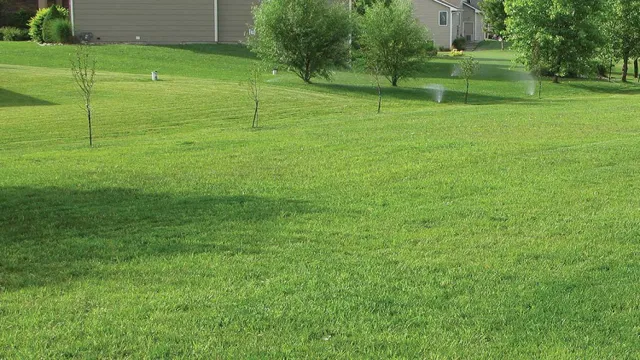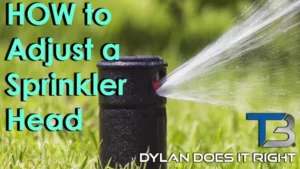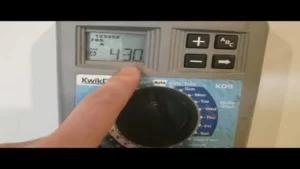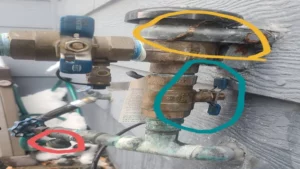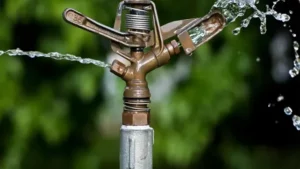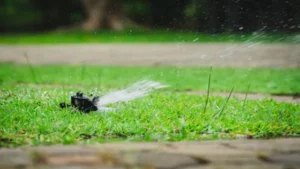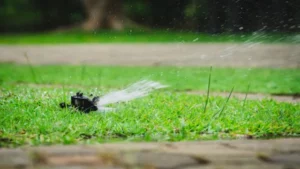Do you find it baffling to determine the number of zones required for your sprinkler system? Don’t worry, you are not alone. Installing an efficient sprinkler system is crucial for maintaining a healthy lawn and garden, but it can be overwhelming to know how many zones you need. Think of your sprinkler system like a puzzle, with each zone representing a unique piece.
Every piece needs to fit together perfectly to create a beautiful picture, and the same goes for your sprinkler system. Each zone must be designed to address specific watering needs based on soil type, sun exposure, and plant types. By dividing your lawn and garden into appropriate zones, you can avoid under or over-watering, which can lead to plant stress or disease.
In addition, the smaller zones ensure efficient water usage by only watering areas that need it, reducing water waste. So, how do you determine the number of zones for your sprinkler system? Start by mapping out your lawn and garden. Identify areas with similar watering needs and group them together.
Remember that different plants have different water needs, so make sure each zone takes this into account. Overall, determining the number of zones for your sprinkler system requires careful planning, but the results are worth it. By dividing your lawn and garden into zones, you can ensure even watering, promote healthy plant growth, and reduce waste.
Factors to Consider
Determining how many zones are needed for a sprinkler system requires you to consider several factors. The size of your lawn plays a significant role in determining the number of zones you need. A larger lawn requires more zones to ensure adequate coverage of water.
Other factors such as soil type, slopes, vegetation, and weather patterns also play a role in determining the number of zones. For example, if your lawn has slopes, you should consider dividing it into smaller zones to prevent oversaturation in one area. Similarly, the vegetation in your lawn can affect the watering needs of specific areas, and the soil type determines how quickly the water is absorbed.
Therefore, it’s essential to consider these factors carefully when designing your sprinkler system to ensure efficient water distribution and proper lawn care. Consulting with a professional landscaper or irrigation contractor can also help you determine the optimal number of zones for your sprinkler system. With the right considerations, you can design a sprinkler system that is both cost-effective and sustainable.
Size and Shape of Lawn
When it comes to maintaining a beautiful lawn, size and shape are important factors to consider. The size of your lawn will determine how much time and energy you’ll need to devote to it, and a lawn that’s too large for your needs can quickly become overwhelming. On the other hand, a small lawn may be easier to manage, but it can be limiting in terms of design options.
In addition to size, the shape of your lawn is also important. Different shapes can complement the overall architecture of your home and create a welcoming atmosphere. For example, a circular lawn can create a sense of flow and movement, while a more rectangular shape can create a sense of structure and orderliness.
Ultimately, you’ll want to choose a size and shape that fits your lifestyle and personal preferences, and take into account the amount of time and resources you have available for lawn maintenance.
Water Pressure and Flow Rate
When it comes to water pressure and flow rate, there are several factors to consider. The first is the size of the pipes carrying the water. Smaller pipes will naturally decrease water flow and pressure.
The second factor is the distance the water has to travel. The longer the distance, the more friction the water will encounter, which reduces pressure. Another factor is the number of fixtures connected to the water source, including faucets, showers, and toilets.
The more fixtures there are, the more water the system will need to supply, and the lower the pressure may be. Additionally, water pressure can vary depending on the time of day and the season, as water usage fluctuates. Understanding these factors can help homeowners or business owners make informed decisions about their water systems and how to optimize water pressure and flow rate.
Type of Sprinkler Heads Used
When it comes to choosing sprinkler heads for your lawn or garden, there are several factors to consider. One of the most important factors is the type of sprinkler head to use. There are several types of sprinkler heads available, each with their own advantages and disadvantages.
Some popular types of sprinkler heads include rotary sprays, pop-up sprays, impact sprinklers, and oscillating sprinklers. Factors to consider include the size and shape of your lawn or garden, the water pressure available, and the type of plants you are watering. For example, if you have a large, open lawn, an impact sprinkler may be the best choice as it can cover a large area.
However, if you have a smaller, more irregularly shaped lawn, a pop-up spray may be a better choice as it can be adjusted to cover specific areas. Ultimately, the type of sprinkler head you choose will depend on your individual needs and preferences.
Type of Soil and Slope of Lawn
When it comes to growing healthy, lush grass in your yard, understanding the type of soil and slope of your lawn is crucial. Factors to consider when evaluating your soil include its composition, pH level, and nutrient content. Sandy soil, for instance, drains quickly but may not retain enough moisture or nutrients for optimal growth, while clay soil holds onto water and nutrients but can become compacted.
A slope can also impact the health of your lawn, affecting water drainage and nutrient absorption. The angle of the slope determines how quickly water runs off, with steeper slopes leading to faster runoff and potentially causing erosion. It’s essential to consider these factors when selecting grass varieties and developing a maintenance routine.
By tailoring your lawn care efforts to your soil type and slope, you can create a thriving, beautiful yard that enhances your home’s curb appeal. So, before you break out the lawnmower or purchase any fertilizer, take the time to evaluate your soil and slope to ensure your efforts result in healthy, green grass.
Calculating Number of Zones
If you’re wondering how to determine how many zones you need for your sprinkler system, there are a few factors that come into play. The size of your yard and the water pressure available are the two main ones. Generally, for every 20-25 gallons per minute (GPM) available, you can have one sprinkler zone.
So if you have a water supply of 50 GPM, you can have two to three zones. Additionally, you’ll want to consider the layout of your yard, including any flower beds, shrubs, or other landscaping features that may require separate watering schedules. A well-designed sprinkler system with multiple zones can save you water and money, as you can tailor each zone’s water usage to the specific needs of the plants in that area.
So take some time to plan out your system and determine the number of zones that will work best for your yard.
Determine Watering Needs of Each Zone
When setting up an irrigation system for your lawn, it is crucial to determine the watering needs of each zone. This means dividing the lawn into different zones based on factors like soil type, sun exposure, and plant types that require different amounts of water. Once you have determined the areas that require similar amounts of water, you can then calculate the number of zones needed for your irrigation system.
This will depend on the size of your lawn, but generally, a home lawn will have between two to six zones. Calculating the number of zones is important because each zone will require its own set of sprinklers and water supply to ensure that each area gets the appropriate amount of water. By understanding the watering needs of your lawn, you can create an efficient and effective irrigation system that will keep your lawn healthy and thriving.
Calculate Water Output of Each Sprinkler Head
Calculating the number of zones in your sprinkler system can be essential in ensuring water efficiency and the proper distribution of water to every area of your lawn. A good starting point is calculating the water output of each sprinkler head, which can vary depending on their type, nozzle size, and pressure settings. Once you have this information, you can determine how many sprinkler heads you need per zone and how many zones are necessary for your lawn size.
It’s important to keep in mind that a high number of sprinkler heads in one zone may lead to insufficient water pressure and coverage, while too few may cause overwatering and uneven distribution. Therefore, proper calculations and planning are crucial to maximize the effectiveness of your sprinkler system and maintain a healthy, green lawn.
Divide Irrigation System Capacity by Water Output
When it comes to dividing your irrigation system into zones, one of the most important factors to consider is the capacity of your system compared to the output of water. This will help you determine how many zones you need to create to adequately water all areas of your lawn or garden. To calculate the number of zones, you’ll need to start by figuring out the total capacity of your irrigation system.
This can be done by consulting the manufacturer’s specifications or by measuring the size of your pipes and valves. Once you know your system’s capacity, you can divide it by the average output of water per hour for your sprinkler heads. This will give you an idea of how much water your system can deliver to each zone, and you can use this information to determine how many zones you need.
It’s important to remember that each zone should be designed to provide enough water for the specific plants or grasses it will be watering. By carefully calculating your system’s capacity and water output, you can create a custom irrigation plan that will keep your lawn and garden healthy and happy.
Consider Maximum Number of Sprinkler Heads per Zone
To ensure efficient irrigation and water distribution, it is crucial to consider the maximum number of sprinkler heads per zone. This means calculating the number of zones required based on the number of sprinklers and water pressure available. Having too many sprinklers on one zone can lead to reduced water pressure and uneven coverage, while having too few sprinklers can result in inadequate irrigation.
Therefore, it is important to strike a balance and distribute the sprinklers equally among the zones. This will not only maximize the effectiveness of the irrigation system but also prevent water wastage and reduce the risk of damage to the sprinklers due to high pressure. By calculating the number of zones required based on factors such as water flow rate, sprinkler type, and terrain, you can create a customized irrigation plan that meets your specific needs while conserving water and minimizing costs.
Conclusion
Determining the number of zones for your sprinkler system is like a game of chess – you need to make strategic moves based on the layout of your yard and the specific needs of your plants. A well-planned system with the right number of zones can save water, time, and money in the long run. So, take your time, analyze the situation, and make your move! Let your sprinkler system be the king of irrigation, reigning over a lush green kingdom.
“
FAQs
What factors should be considered when determining the number of zones needed for a sprinkler system?
The size and shape of the yard, the type of soil, the type of plants or grass being watered, and the water pressure available all play a role in determining the number of zones needed for a sprinkler system.
How do you measure water pressure for a sprinkler system?
Water pressure may be checked using a pressure gauge at the main water source or by consulting with a professional irrigation specialist.
Can different types of sprinkler heads be used in the same zone?
Generally, no. Sprinkler heads are designed to have specific watering patterns and coverage areas, so using different types of heads in the same zone can lead to uneven watering and wasted water.
What maintenance is required for a sprinkler system?
Regular inspection of sprinkler heads and pipes, adjustment of water flow and pressure as necessary, and winterization in colder climates are all important maintenance tasks for a sprinkler system.
How can I conserve water when using a sprinkler system?
Adjusting watering times based on weather conditions, using drip irrigation for plants and trees, and selecting water-efficient sprinkler heads can all help conserve water when using a sprinkler system.
Can a sprinkler system be installed on my own or should I hire a professional?
While installation of a sprinkler system can be done by a knowledgeable DIYer, it is recommended to hire a professional to ensure proper installation and avoid potential damage to landscaping and other underground utilities.
How do I set up a watering schedule for my sprinkler system?
Many sprinkler systems have timers that allow for varying watering schedules based on the day of the week and time of day. Consult with a professional or refer to the manufacturer’s instructions for specific guidance on setting up a watering schedule.
